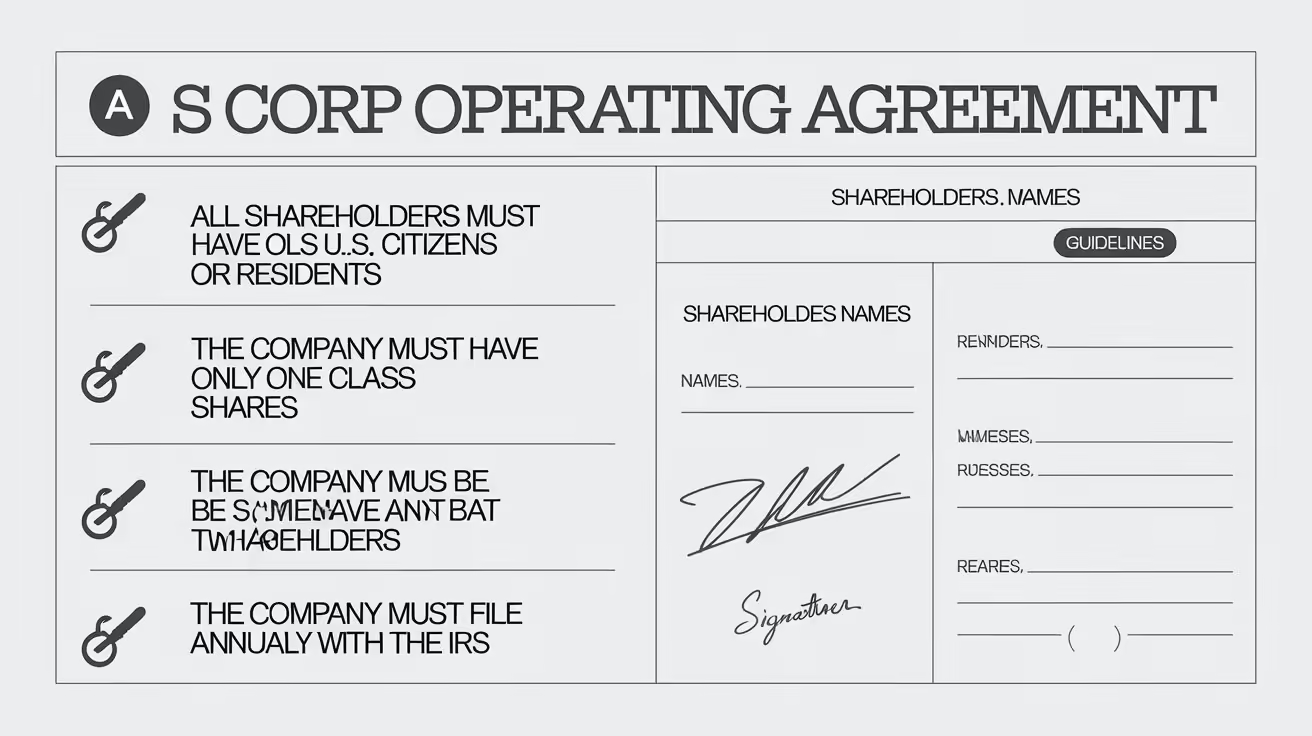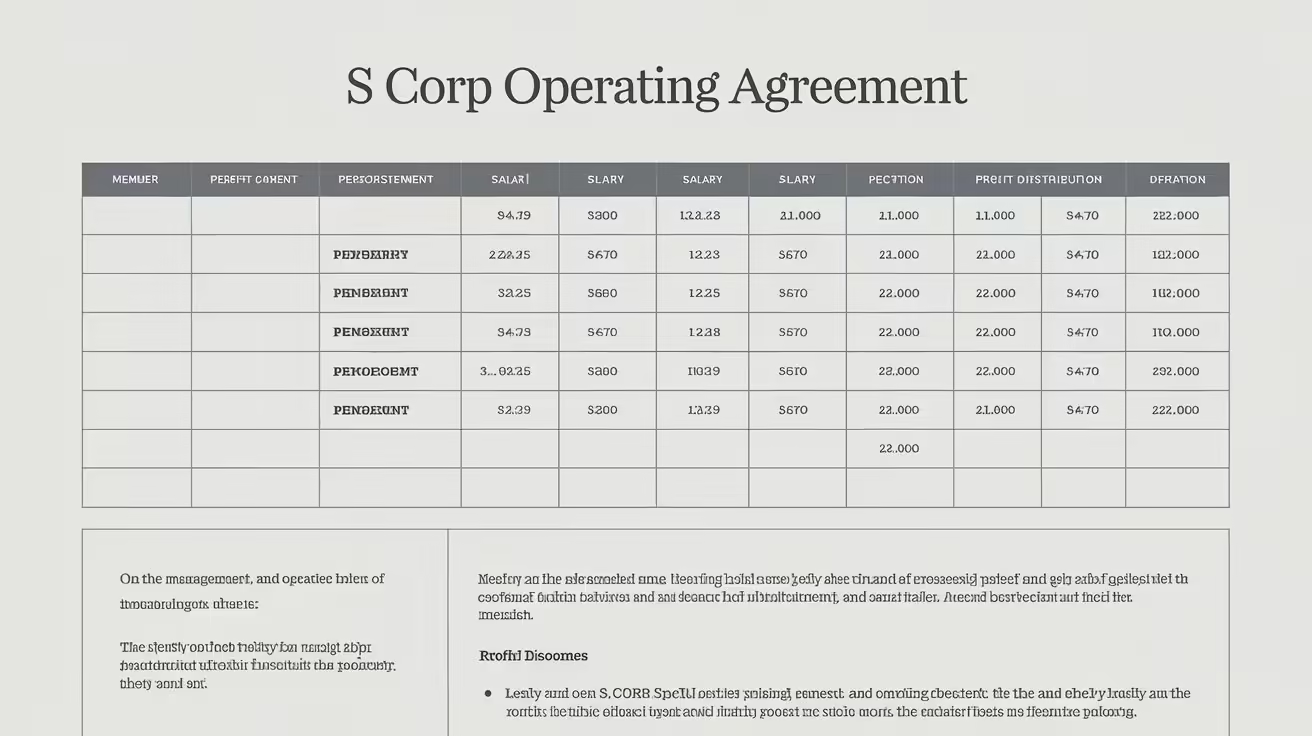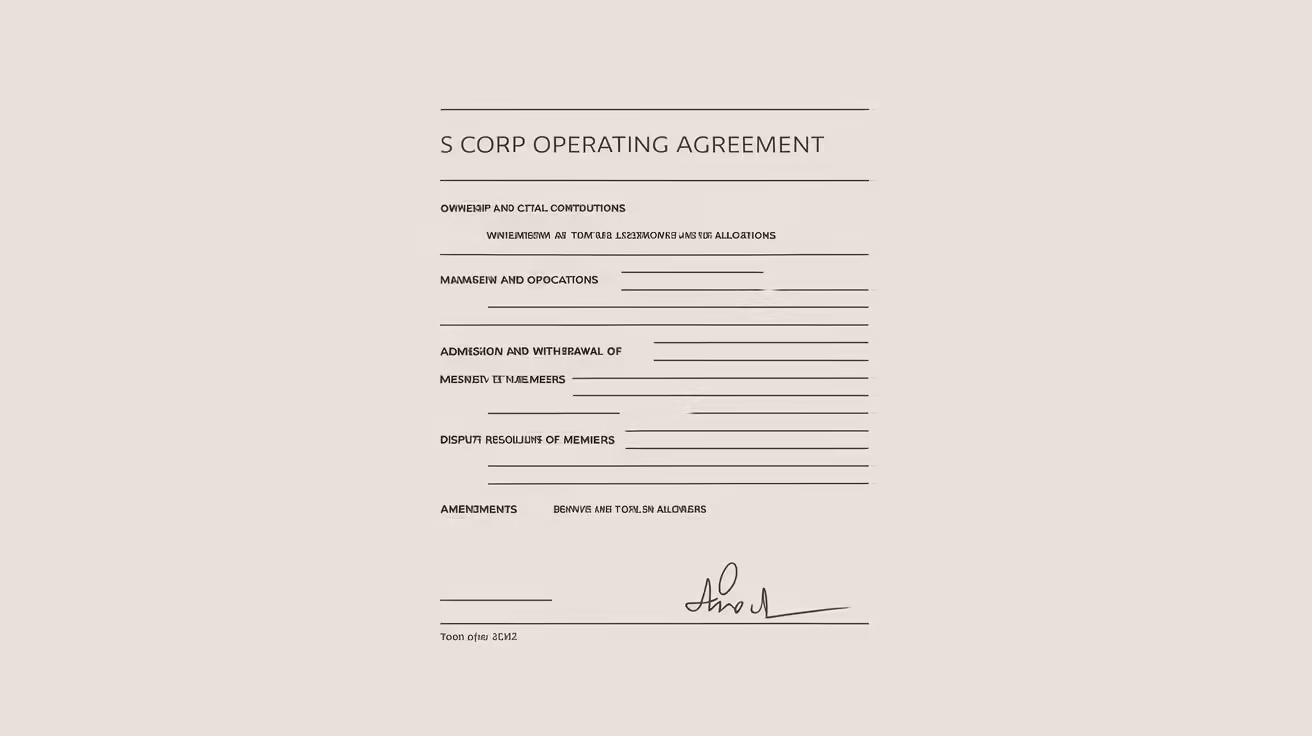S Corp Operating Agreement: Your Blueprint for Corporate Success

An S Corp Operating Agreement is often overlooked but vital to the smooth functioning of an S Corporation. Whether you’re starting a new business or converting an existing company into an S Corporation, this agreement sets the foundation for ownership, roles, and management expectations. Without it, your business may lack the structure needed to avoid disputes and complications. Let’s dive into why this document is essential and how it ensures the long-term success of your S Corporation.
Understanding the S Corp Operating Agreement
An S Corp Operating Agreement is a formal document that outlines the internal management of an S Corporation. Although S Corps are not legally required to have an operating agreement in some states, having one ensures clarity in the roles and responsibilities of owners, shareholders, and officers. It acts as a contract among the shareholders, guiding decision-making, resolving disputes, and setting forth the ownership and management structure of the company.
Many people confuse S Corporations with Limited Liability Companies (LLCs), which are typically required to have an operating agreement. Even though the legal requirements differ, an S Corp Operating Agreement serves a similar purpose—it clearly defines how the corporation will operate and how profits will be distributed. This agreement is vital because it minimizes misunderstandings and ensures all parties are on the same page from the beginning.
Why is an S Corp Operating Agreement Important?
At the heart of any well-functioning business is clear communication and structure, both of which an S Corp Operating Agreement provides. Some of the primary reasons this document is essential include:
- Clarification of Roles and Responsibilities: Each shareholder, officer, and director needs to understand their role in the business. Without clarity, disputes can arise, leading to confusion and operational inefficiency.
- Avoiding Conflicts: Disagreements among shareholders are inevitable in any business. The S Corp Operating Agreement helps resolve these disputes by clearly outlining procedures for decision-making and conflict resolution.
- Ensuring Legal Compliance: While S Corporations enjoy certain tax advantages, failure to comply with specific rules can cause the IRS to revoke your S Corp status. An operating agreement ensures that your business adheres to these requirements, protecting your corporate status.
- Documenting Ownership and Profit Distribution: This agreement solidifies who owns what percentage of the company and how profits (or losses) will be distributed. Without this, there’s room for misinterpretation and unfair distributions.
What Should Be Included in an S Corp Operating Agreement?
A well-drafted S Corp Operating Agreement is comprehensive and detailed. It covers a wide range of topics, from ownership structure to day-to-day operations. The agreement should be tailored to your corporation’s specific needs but generally includes the following elements:
Ownership and Equity Structure
One of the most critical components of an S Corp Operating Agreement is a clear delineation of ownership. It should state how many shares each shareholder owns, how much each shareholder contributed, and whether any shareholders have preferential rights. Without this, there may be disputes over ownership percentages or shareholder privileges.
In addition, the agreement should outline how new shares will be issued and what happens when a shareholder wants to sell or transfer their shares. Will the company have first right of refusal? Will shareholders need to approve the transfer of shares? These questions need to be answered to avoid future issues.
Voting Rights and Decision-Making Procedures
The S Corp Operating Agreement should outline how decisions will be made within the corporation. Are voting rights proportional to the number of shares owned, or does each shareholder get one vote regardless of their stake? Clarifying these details will prevent future confusion when significant decisions need to be made.
For example, some decisions may require unanimous approval, while others might only need a majority vote. An S Corp Operating Agreement should specify the voting procedures for various types of decisions, such as electing officers, merging with another company, or selling the business.
Distributions and Dividends
In an S Corporation, shareholders can receive distributions of the corporation’s profits. However, these distributions must be made according to the ownership percentages to avoid jeopardizing the S Corp’s tax status. An S Corp Operating Agreement should detail how and when these distributions will occur.
It’s also a good idea to address what happens if the corporation experiences losses. Will shareholders need to make additional contributions, or will the losses be carried over to future years?
Management Structure
Unlike LLCs, which are often member-managed, S Corporations usually have a more formalized management structure. The S Corp Operating Agreement should clearly define the roles of officers, directors, and shareholders. It should also specify how officers and directors will be elected, their duties, and their terms of service.
For smaller S Corporations, these roles might overlap, with shareholders also serving as officers or directors. However, in larger companies, these roles are often distinct, and the operating agreement should clarify the hierarchy and responsibilities.
Meetings and Record-Keeping
S Corporations are required by law to hold annual meetings and maintain proper records of these meetings. Failing to do so can result in the corporation losing its limited liability protection. The S Corp Operating Agreement should specify when and how these meetings will be held, who is required to attend, and what topics will be covered.
In addition, the agreement should detail how records will be kept and who will be responsible for maintaining corporate documents. Proper record-keeping is essential for maintaining transparency and accountability within the corporation.

The Legal Significance of an S Corp Operating Agreement
Although not legally required in every state, an S Corp Operating Agreement can provide significant legal protection. In the event of a dispute among shareholders or a legal challenge from a third party, the operating agreement can serve as a legally binding document that outlines the corporation’s procedures and decisions. This is especially important when there are conflicting interpretations of verbal agreements or informal understandings between shareholders.
Additionally, the operating agreement reinforces the separation between the shareholders and the corporation, helping to protect shareholders from personal liability. Without this clear separation, a court could “pierce the corporate veil” and hold shareholders personally liable for the corporation’s debts and obligations.
Common Mistakes When Drafting an S Corp Operating Agreement
While it’s essential to have an S Corp Operating Agreement, drafting one can be a complex process. Many businesses make mistakes that can undermine the effectiveness of the agreement. Here are some common pitfalls to avoid:
Using a Generic Template
Every business is unique, and using a one-size-fits-all template may not address your corporation’s specific needs. A generic operating agreement might leave out critical provisions or include terms that don’t apply to your business. It’s essential to tailor the agreement to fit your corporation’s particular circumstances.
Failing to Update the Agreement
As your business evolves, so should your S Corp Operating Agreement. Failing to update the document when new shareholders join, roles change, or significant decisions are made can create confusion and legal challenges down the road. Regularly reviewing and updating the agreement ensures it remains relevant and effective.
Not Consulting a Legal Professional
While you can certainly draft an S Corp Operating Agreement on your own, it’s a good idea to consult with a legal professional to ensure the document is legally sound and comprehensive. A lawyer can help you address potential issues you may not have considered and ensure that the agreement complies with state laws.
S Corp Operating Agreement vs. Bylaws: What’s the Difference?
Many people confuse an S Corp Operating Agreement with corporate bylaws, but they serve different purposes. Corporate bylaws outline the overall governance of the corporation, including the responsibilities of the board of directors, how meetings will be conducted, and how officers will be appointed. The S Corp Operating Agreement, on the other hand, focuses on the specific management and operational structure of the S Corporation, including how profits will be distributed and how decisions will be made among shareholders.
Both documents are important for ensuring the smooth operation of the corporation, but they serve distinct functions. It’s important to have both a well-drafted set of bylaws and an S Corp Operating Agreement to cover all aspects of corporate governance. S Corporation vs Sole Proprietor: Master the 5 Art of Business Structure

How to Draft an Effective S Corp Operating Agreement
Drafting an S Corp Operating Agreement may seem daunting, but following a few simple steps can make the process more manageable. Here’s a guide to creating a comprehensive and effective agreement:
1. Start with Basic Information
The first step is to gather basic information about your corporation, including the names of shareholders, the number of shares issued, and the corporation’s address. This section should also include the corporation’s purpose and how long it’s expected to operate.
2. Define Ownership and Roles
Next, outline the ownership structure and define the roles of each shareholder. Clearly state how many shares each person owns, what their responsibilities are, and how profits will be distributed.
3. Establish Voting and Decision-Making Procedures
Decide how decisions will be made within the corporation. Will shareholders have equal voting rights, or will voting power be proportional to ownership? Specify how voting will occur for major decisions, such as electing officers or selling the corporation.
4. Set Rules for Distributions
Clearly outline how and when profits will be distributed to shareholders. Specify whether distributions will occur quarterly, annually, or at the discretion of the board.
5. Include Management and Meeting Procedures
Define the corporation’s management structure and specify how and when meetings will be held. This section should also detail the process for keeping records and maintaining compliance with state and federal regulations.
The Importance of Regularly Reviewing Your S Corp Operating Agreement
As your business grows and evolves, your S Corp Operating Agreement should evolve with it. Regularly reviewing and updating the agreement ensures that it reflects the current reality of your corporation’s ownership and operations. Any changes in shareholders, new investments, or alterations in the management structure should be reflected in the updated agreement. Regular updates also help maintain compliance with legal requirements, especially if your corporation operates in multiple states.
Protecting the Corporate Veil with an S Corp Operating Agreement
One of the primary benefits of incorporating as an S Corporation is the limited liability protection it offers to its shareholders. This protection, often referred to as the “corporate veil,” ensures that the personal assets of shareholders are protected from the debts and liabilities of the corporation. However, to maintain this protection, it’s crucial that the corporation adheres to certain formalities, including the proper drafting and implementation of an S Corp Operating Agreement. Can I Convert LLC to S Corp? Unlocking the 5 Key Benefits
Failing to maintain corporate formalities can result in the “piercing of the corporate veil,” where courts disregard the corporation’s separate legal status and hold shareholders personally liable for the corporation’s obligations. A comprehensive S Corp Operating Agreement helps demonstrate that the corporation is operating as a distinct legal entity. This agreement outlines the procedures for managing the corporation, ensuring compliance with state and federal regulations, and formally recognizing the separation between the shareholders and the corporation itself.
In addition, regularly holding meetings and maintaining accurate records of those meetings, as stipulated in the S Corp Operating Agreement, can further protect the corporate veil. Adhering to these guidelines shows that the business is following proper corporate governance practices, which can be critical in legal disputes.
Tax Advantages and the S Corp Operating Agreement
One of the main reasons businesses choose the S Corporation structure is the potential for significant tax savings. Unlike C Corporations, S Corporations benefit from “pass-through” taxation, meaning the corporation’s profits and losses are passed directly to the shareholders and taxed at their individual income tax rates. This avoids the double taxation that C Corporations face, where both the corporation and its shareholders are taxed.
However, maintaining the S Corporation’s tax status requires adherence to strict IRS guidelines, and an S Corp Operating Agreement can play a pivotal role in ensuring compliance with these rules. For instance, the IRS mandates that S Corporations have no more than 100 shareholders and that all shareholders must be U.S. citizens or residents. Additionally, S Corporations can only issue one class of stock, although differences in voting rights are permitted.
An S Corp Operating Agreement should include provisions that reinforce these restrictions, ensuring that the corporation’s actions do not jeopardize its S Corp status. This agreement can help the corporation avoid mistakes such as issuing multiple classes of stock or admitting an ineligible shareholder, both of which could lead to the loss of the S Corporation’s tax benefits.

Dispute Resolution and the S Corp Operating Agreement
Even in the most harmonious business partnerships, disputes can arise. Whether it’s a disagreement over profit distribution, shareholder rights, or management decisions, these conflicts can disrupt the business’s operations and damage relationships between shareholders. An S Corp Operating Agreement is crucial in providing a framework for resolving these disputes before they escalate into costly legal battles.
A well-crafted S Corp Operating Agreement should outline specific procedures for handling disagreements among shareholders. This can include mediation or arbitration clauses, which provide alternatives to litigation. By including clear dispute resolution mechanisms in the agreement, the corporation can address conflicts in a structured and efficient manner, minimizing disruptions to the business.
In addition, the agreement should address what happens if a shareholder wishes to exit the business or if there is a need to dissolve the corporation. These provisions ensure that all shareholders are aware of the steps to be taken in such situations, preventing misunderstandings and preserving the corporation’s value.
Protecting the Corporate Veil with an S Corp Operating Agreement
One of the primary benefits of incorporating as an S Corporation is the limited liability protection it offers to its shareholders. This protection, often referred to as the “corporate veil,” ensures that the personal assets of shareholders are protected from the debts and liabilities of the corporation. However, to maintain this protection, it’s crucial that the corporation adheres to certain formalities, including the proper drafting and implementation of an S Corp Operating Agreement.
Failing to maintain corporate formalities can result in the “piercing of the corporate veil,” where courts disregard the corporation’s separate legal status and hold shareholders personally liable for the corporation’s obligations. A comprehensive S Corp Operating Agreement helps demonstrate that the corporation is operating as a distinct legal entity. This agreement outlines the procedures for managing the corporation, ensuring compliance with state and federal regulations, and formally recognizing the separation between the shareholders and the corporation itself.
In addition, regularly holding meetings and maintaining accurate records of those meetings, as stipulated in the S Corp Operating Agreement, can further protect the corporate veil. Adhering to these guidelines shows that the business is following proper corporate governance practices, which can be critical in legal disputes.
Tax Advantages and the S Corp Operating Agreement
One of the main reasons businesses choose the S Corporation structure is the potential for significant tax savings. Unlike C Corporations, S Corporations benefit from “pass-through” taxation, meaning the corporation’s profits and losses are passed directly to the shareholders and taxed at their individual income tax rates. This avoids the double taxation that C Corporations face, where both the corporation and its shareholders are taxed.
However, maintaining the S Corporation’s tax status requires adherence to strict IRS guidelines, and an S Corp Operating Agreement can play a pivotal role in ensuring compliance with these rules. For instance, the IRS mandates that S Corporations have no more than 100 shareholders and that all shareholders must be U.S. citizens or residents. Additionally, S Corporations can only issue one class of stock, although differences in voting rights are permitted.
An S Corp Operating Agreement should include provisions that reinforce these restrictions, ensuring that the corporation’s actions do not jeopardize its S Corp status. This agreement can help the corporation avoid mistakes such as issuing multiple classes of stock or admitting an ineligible shareholder, both of which could lead to the loss of the S Corporation’s tax benefits.
Dispute Resolution and the S Corp Operating Agreement
Even in the most harmonious business partnerships, disputes can arise. Whether it’s a disagreement over profit distribution, shareholder rights, or management decisions, these conflicts can disrupt the business’s operations and damage relationships between shareholders. An S Corp Operating Agreement is crucial in providing a framework for resolving these disputes before they escalate into costly legal battles.
A well-crafted S Corp Operating Agreement should outline specific procedures for handling disagreements among shareholders. This can include mediation or arbitration clauses, which provide alternatives to litigation. By including clear dispute resolution mechanisms in the agreement, the corporation can address conflicts in a structured and efficient manner, minimizing disruptions to the business. Can I Convert LLC to S Corp? Unlocking the 5 Key Benefits
In addition, the agreement should address what happens if a shareholder wishes to exit the business or if there is a need to dissolve the corporation. These provisions ensure that all shareholders are aware of the steps to be taken in such situations, preventing misunderstandings and preserving the corporation’s value.
Protecting the Corporate Veil with an S Corp Operating Agreement
One of the primary benefits of incorporating as an S Corporation is the limited liability protection it offers to its shareholders. This protection, often referred to as the “corporate veil,” ensures that the personal assets of shareholders are protected from the debts and liabilities of the corporation. However, to maintain this protection, it’s crucial that the corporation adheres to certain formalities, including the proper drafting and implementation of an S Corp Operating Agreement.
Failing to maintain corporate formalities can result in the “piercing of the corporate veil,” where courts disregard the corporation’s separate legal status and hold shareholders personally liable for the corporation’s obligations. A comprehensive S Corp Operating Agreement helps demonstrate that the corporation is operating as a distinct legal entity. This agreement outlines the procedures for managing the corporation, ensuring compliance with state and federal regulations, and formally recognizing the separation between the shareholders and the corporation itself.
In addition, regularly holding meetings and maintaining accurate records of those meetings, as stipulated in the S Corp Operating Agreement, can further protect the corporate veil. Adhering to these guidelines shows that the business is following proper corporate governance practices, which can be critical in legal disputes.
Tax Advantages and the S Corp Operating Agreement
One of the main reasons businesses choose the S Corporation structure is the potential for significant tax savings. Unlike C Corporations, S Corporations benefit from “pass-through” taxation, meaning the corporation’s profits and losses are passed directly to the shareholders and taxed at their individual income tax rates. This avoids the double taxation that C Corporations face, where both the corporation and its shareholders are taxed.
However, maintaining the S Corporation’s tax status requires adherence to strict IRS guidelines, and an S Corp Operating Agreement can play a pivotal role in ensuring compliance with these rules. For instance, the IRS mandates that S Corporations have no more than 100 shareholders and that all shareholders must be U.S. citizens or residents. Additionally, S Corporations can only issue one class of stock, although differences in voting rights are permitted.
An S Corp Operating Agreement should include provisions that reinforce these restrictions, ensuring that the corporation’s actions do not jeopardize its S Corp status. This agreement can help the corporation avoid mistakes such as issuing multiple classes of stock or admitting an ineligible shareholder, both of which could lead to the loss of the S Corporation’s tax benefits.
Dispute Resolution and the S Corp Operating Agreement
Even in the most harmonious business partnerships, disputes can arise. Whether it’s a disagreement over profit distribution, shareholder rights, or management decisions, these conflicts can disrupt the business’s operations and damage relationships between shareholders. An S Corp Operating Agreement is crucial in providing a framework for resolving these disputes before they escalate into costly legal battles.
A well-crafted S Corp Operating Agreement should outline specific procedures for handling disagreements among shareholders. This can include mediation or arbitration clauses, which provide alternatives to litigation. By including clear dispute resolution mechanisms in the agreement, the corporation can address conflicts in a structured and efficient manner, minimizing disruptions to the business.
In addition, the agreement should address what happens if a shareholder wishes to exit the business or if there is a need to dissolve the corporation. These provisions ensure that all shareholders are aware of the steps to be taken in such situations, preventing misunderstandings and preserving the corporation’s value.
For more information regarding Finance Basic you can visit FinancewithAi Channel & Home
FAQs
What is an S Corp Operating Agreement?
An S Corp Operating Agreement is a legal document that outlines the ownership structure, roles, responsibilities, and operational procedures of an S Corporation. While not always legally required, it is crucial for defining how the corporation will be run and resolving disputes.
Is an S Corp Operating Agreement required by law?
In many states, an S Corp Operating Agreement is not legally required, but it is highly recommended. Having one ensures clarity and legal protection for shareholders and helps the corporation maintain compliance with IRS regulations.
What happens if an S Corporation doesn’t have an Operating Agreement?
Without an S Corp Operating Agreement, the corporation may face disputes among shareholders, lack clarity in management roles, and risk losing its S Corp status due to non-compliance with IRS regulations.
Can an S Corp Operating Agreement be amended?
Yes, an S Corp Operating Agreement can and should be amended as the business evolves. Changes in ownership, management, or operations should be reflected in an updated agreement to maintain clarity and legal protection.
Who should draft an S Corp Operating Agreement?
While business owners can draft an S Corp Operating Agreement themselves, it’s advisable to consult with a legal professional. A lawyer can ensure that the agreement is comprehensive, legally binding, and compliant with state laws.
How is an S Corp Operating Agreement different from corporate bylaws?
Corporate bylaws govern the overall structure and management of a corporation, while an S Corp Operating Agreement focuses on the specific operations of the S Corporation, including profit distribution and decision-making processes.
Conclusion
In conclusion, an S Corp Operating Agreement is essential for the smooth operation of any S Corporation. While not always legally required, this document provides clarity, prevents disputes, and ensures that the corporation complies with IRS regulations. By clearly defining ownership, roles, voting rights, and profit distributions, the operating agreement sets the foundation for corporate success. Regularly reviewing and updating the agreement ensures that it remains relevant and effective as the corporation grows. Whether you’re starting a new S Corporation or updating an existing one, investing time in drafting a comprehensive operating agreement is a wise decision that will benefit your business in the long run.